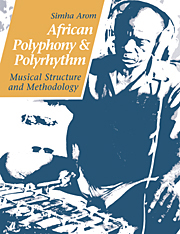Book contents
- Frontmatter
- Contents
- List of illustrations
- Foreword by György Ligeti
- Preface
- Acknowledgements
- BOOK I THE MUSIC OF THE CENTRAL AFRICAN REPUBLIC
- BOOK II AFRICAN POLYPHONIC MUSIC
- BOOK III TECHNICAL TOOLS: METHODS OF RECORDING POLYPHONIC MUSIC FOR TRANSCRIPTION
- 1 The need for transcription
- 2 The difficulties of transcription
- 3 Earlier methods
- 4 Towards a new method
- 5 Theoretical assumptions
- 6 Technical equipment: description and use
- 7 From recording to transcription
- 8 Checking the results
- 9 Potentialities
- 10 Anthropological validity
- BOOK IV THEORETICAL TOOLS
- BOOK V THE ORGANISATION OF TIME IN AFRICAN MUSIC
- BOOK VI STRUCTURAL PRINCIPLES AND THEIR APPLICATION
- Conclusion
- Bibliography
1 - The need for transcription
Published online by Cambridge University Press: 27 January 2010
- Frontmatter
- Contents
- List of illustrations
- Foreword by György Ligeti
- Preface
- Acknowledgements
- BOOK I THE MUSIC OF THE CENTRAL AFRICAN REPUBLIC
- BOOK II AFRICAN POLYPHONIC MUSIC
- BOOK III TECHNICAL TOOLS: METHODS OF RECORDING POLYPHONIC MUSIC FOR TRANSCRIPTION
- 1 The need for transcription
- 2 The difficulties of transcription
- 3 Earlier methods
- 4 Towards a new method
- 5 Theoretical assumptions
- 6 Technical equipment: description and use
- 7 From recording to transcription
- 8 Checking the results
- 9 Potentialities
- 10 Anthropological validity
- BOOK IV THEORETICAL TOOLS
- BOOK V THE ORGANISATION OF TIME IN AFRICAN MUSIC
- BOOK VI STRUCTURAL PRINCIPLES AND THEIR APPLICATION
- Conclusion
- Bibliography
Summary
Western culture has been shaped for the past several thousand years by its use of writing as a vehicle for thought, making a written support indispensable for any academic study. Music is no exception to this rule, and would seem extremely difficult to analyse in depth unless first reduced to the form of a written score, i.e., a transcription in the case of music from an oral tradition. The essential transience of music requires that its movement through time be fixed in writing as a substantive ‘reference text’ for the living reality. This is what the ethnomusicologist's attempts at transcription aim to provide, whatever the geographical or ethnic source of his material. If this is true of monodic music, it is even more so in the case of polyphony, where the simultaneity of events results in a much more complex musical lattice. Transcription is thus all the more necessary, though commensurately harder to achieve.
In his Theory and Method in Ethnomusicology (1964), Bruno Nettl highlights both the need for transcription and all the intrinsic difficulties attending it. He distinguishes two main approaches to the description of music: the first consists of analysing and describing what one hears, while the second involves writing down what one hears and then describing the audible phenomena, relying on the observations contained in the transcription.
- Type
- Chapter
- Information
- African Polyphony and PolyrhythmMusical Structure and Methodology, pp. 94 - 95Publisher: Cambridge University PressPrint publication year: 1991



